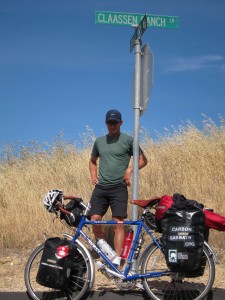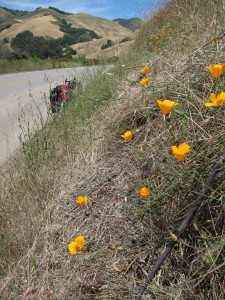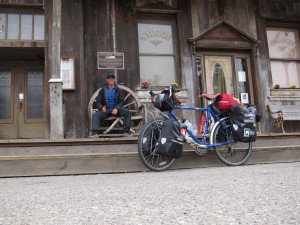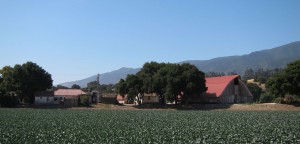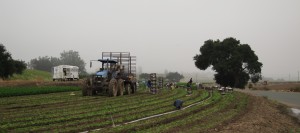15 Jun, 2011
California means a lot different things to different people. For some, it is a land of incessant sunshine where Hollywood icons stroll the streets en route to the latest scandal or maybe the governor’s mansion– or both. For others, it is a bastion of hedonism where liberal ideals spring up like weeds. Some think of the state’s unparalleled natural beauty and outdoor activities as evidenced in the majesty of Half Dome, the desolation of Death Valley, the mystery of Joshua Tree, the wildness of the Big Sur coastline, and the grandeur of the redwoods. There’s the Golden Gate, Tahoe, LA, and whole lot more. For me, the primary elements of California are those most abundant in the central part of the state: bright orange and yellow poppies growing in the foxtails; rolling hills covered with light yellow grass and sparse live oak trees tickled by fog from the ocean in the morning then beaten dry by the afternoon sun; red-tailed hawks screaming out into a silent valley; verdant fields being worked by hands with bent backs to deliver food to our tables; cattle grazing while oil rigs pump in the distance. This is the backbone of California. This is my childhood home.
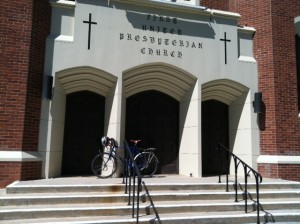
Here's Thaddeus in that same spot yesterday. This church has undergone major changes since my childhood, including a new sanctuary down the street that houses thousands of people in a "contemporary" setting.
Over the past week, I biked from Santa Barbara to Salinas. This region of California is the setting for many of my earliest memories. I spent the first 12 years of my life between Salinas and Monterey. After a few years in Carmel, I headed south to Santa Barbara for boarding school. My father’s family–Claassens and Franklins–are considered pioneers of the Paso Robles area. As I biked this stretch of central California, I pedaled through canyons where my great grandparents drove cattle. My parents instilled in me a deep appreciation for the region’s back roads, many of which I have been driving all of my life. On the bicycle, I discovered that the roads I considered small are major thoroughfares to many. I also got the chance to explore some very small roads that I would have left unexplored in a car. Such is the glory of the bicycle.

Swallows between Los Olivos and Guadalupe. I came across swallows at every bridge or abandoned building along the way.
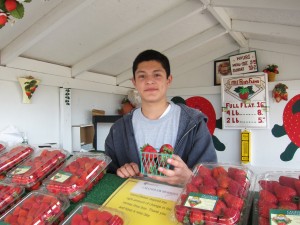
I stopped at this fruit shack for a few strawberries. After talking with this kid, he ended up giving me the little basket in his hand for FREE! The berries were among the best I've ever had in my life, and I grew up in this area. Funny how good food tastes when you are hungry and it is free! Thanks to all strangers who show kindness in this way and others.
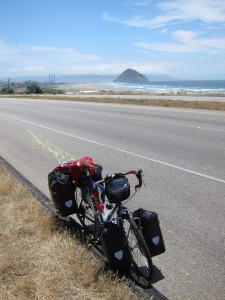 The cycling went surprisingly well. I ended up doing over 60 miles a day, which exceeded my intended parameters of 40-60mi throughout this trip. On my way to Solvang, I ended up with 72 miles for the day after 65 the previous day and the knowledge that a hilly 60+ awaited me the next morning. Despite the numbers, the riding has been great. Lest you mistake my enthusiasm for lack of effort, consider the difficulty of pedaling a fully loaded bicycle into 12 mph head winds when you average 13 mph– on a good day. Such is the life of a touring cyclist in central CA. However, gracias a Dios, I have yet to injure myself or hit the wall. I came very close to “bonking” on a 5 mile climb through a narrow canyon 45 miles into my ride to Paso Robles. Luckily, I took a dip in a cold stream and returned to the bike refreshed.
The cycling went surprisingly well. I ended up doing over 60 miles a day, which exceeded my intended parameters of 40-60mi throughout this trip. On my way to Solvang, I ended up with 72 miles for the day after 65 the previous day and the knowledge that a hilly 60+ awaited me the next morning. Despite the numbers, the riding has been great. Lest you mistake my enthusiasm for lack of effort, consider the difficulty of pedaling a fully loaded bicycle into 12 mph head winds when you average 13 mph– on a good day. Such is the life of a touring cyclist in central CA. However, gracias a Dios, I have yet to injure myself or hit the wall. I came very close to “bonking” on a 5 mile climb through a narrow canyon 45 miles into my ride to Paso Robles. Luckily, I took a dip in a cold stream and returned to the bike refreshed.
This week, I’ve visited churches all across the denominational spectrum: Lutheran, Evangelical missionary non-denominational, Catholic, UCC, and Presbyterian.

In the psuedo-Danish village of Solvang--which is the area made famous by the movie Sideways, Bethania Lutheran church hosted me. Bethania has a "Green Team" of 6 folks who assess the church's expenditures and efficiency. Thanks again to Kristyl and Pastor Tarkki!
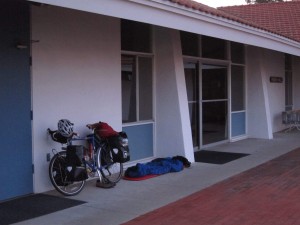
They offered me a comfortable spot in their courtyard after my initial host had to cancel at the last minute.
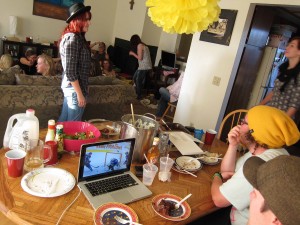
In Pismo Beach, the incredibly friendly folks at the local Youth With A Mission (YWAM) hosted me. They provided me with my own room and bed and treated me to dinner-- despite the fact that my contact and his wife had a baby barely over one week old and their group had just returned from a mission trip of 2 months the night before. Here we are all feasting for their first joint meal after traveling.
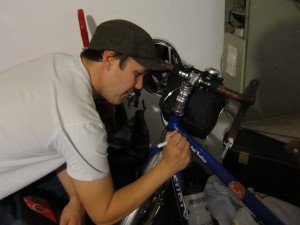
Thaddeus gets another signature. Thanks again to Will and all of the folks at YWAM Pismo Beach. For more on their governing organization, see http://www.ywam.org/.
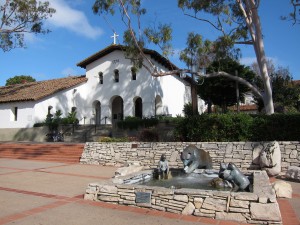
Here's Thaddeus at the Mission San Luis Obispo. This is the first place that I attended a Catholic mass as a child. In the foreground, you can see a sculpture that depicts the region before the arrival of the Spanish missionaries just a few hundred years ago. The missionaries noted huge populations of brown bears, which no doubt fed on the steelhead salmon that used to run these rivers. Even my father remembers fishing for steelhead in San Luis as a child. Those days are long past. However, on my arrival day, the mission held a service day of environmental concern.
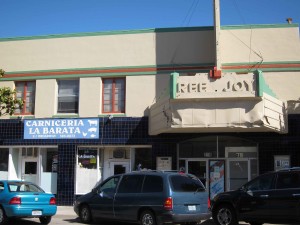
After a visit to Plymouth Congregational UCC and a rest day in Paso Robles, I headed north to the town of King City. Although King City has the most Anglo name in the Salinas Valley, it is easy to mistake much of it for Mexico. Spanish is the default language of the town, and business fluctuates in extremes depending on the crop season.
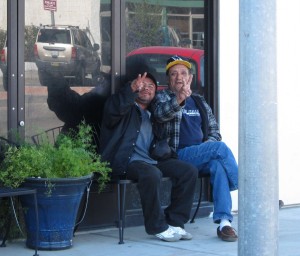
These friendly King City tios insisted on a photo after they saw me taking the previous shot. Buena onda!
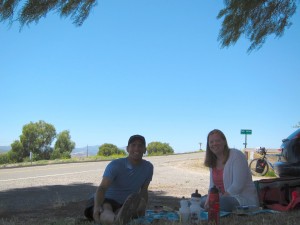
On my way from Paso Robles to King City, I had a visitor from the Thad's community. Ann Scharnhorst has just begun a trip to visit all of her facebook friends in person (see: http://connectingcrosscountry.wordpress.com/ for more). Although Ann and I had never met, she befriended me through the Thad's community, which she has been a part of for the past 6 months. We had an incredible picnic along a quiet road overlooking the Salinas Valley. As we ate, the wind picked up, which made the remaining 10 miles to King City very slow. To avoid a repeat performance, I got a very early start for Salinas the next day. Thanks again to Ann for lunch and her support! Good luck on the road!

In the town of San Ardo, I stopped into this an old store/pub. On the outside, it looked like it had been closed for 30 years. The sign said open, but the two sets of double doors were closed and uninviting. However, I was shocked to find the owner in there alone. When we first started talking, this salty, Yoda-like character was far from friendly. He had no taste for my generation's addiction to smartphones and inarticulate language--particularly the word "cool." Eventually, he warmed up to me.

The San Ardo pit stop was worth the initial tension. The owner had a hat collection that covered the walls. Apparently, he had another 1,500 in the back! The seats and bar you see here were worn from over 60 years of regular use.
As you have undoubtedly noticed, there is so much to report in these weekly blogs that some of the best parts will go unreported. However, I hope to provide a sampling of the week’s adventures and pass on the general spirit of adventure. Of course, there’s always more to say. Although this post might seem removed from the overall carbon element, consider the following pictures as another part of central California scenery:
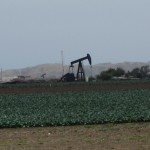


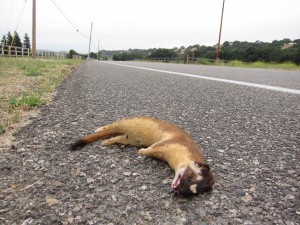
 Home is a curious notion. While the feelings we associate with a particular place are extraordinarily strong, it is also worth noting the value of being at home wherever we are. I aspire to both recognize my deep connection to the land and ecosystem in which I live and seek the comfort of being connected to all things in all that I do. This latter goal requires living into the person that I am and “being at home in my own skin”–as the cliche goes. Bringing the Carbon Sabbath to the region of my childhood memories has done that for me. Yes– some folks question the urgency of the related issues or legitimacy of my means. But the resulting dialogue has proved worthwhile.
Home is a curious notion. While the feelings we associate with a particular place are extraordinarily strong, it is also worth noting the value of being at home wherever we are. I aspire to both recognize my deep connection to the land and ecosystem in which I live and seek the comfort of being connected to all things in all that I do. This latter goal requires living into the person that I am and “being at home in my own skin”–as the cliche goes. Bringing the Carbon Sabbath to the region of my childhood memories has done that for me. Yes– some folks question the urgency of the related issues or legitimacy of my means. But the resulting dialogue has proved worthwhile.
All over Salinas, there are signs, murals, and museums commemorating the work of John Steinbeck. Despite his legendary status, Steinbeck was not easily accepted in this community because he wrote about issues that made people face problems that they would rather avoid. He did so in such a way that his work resonated with people all around the world facing other forms of hardship. Such is the success of the compassionate heart.
Until next week, when we meet again
more compassionate than we thought possible.


